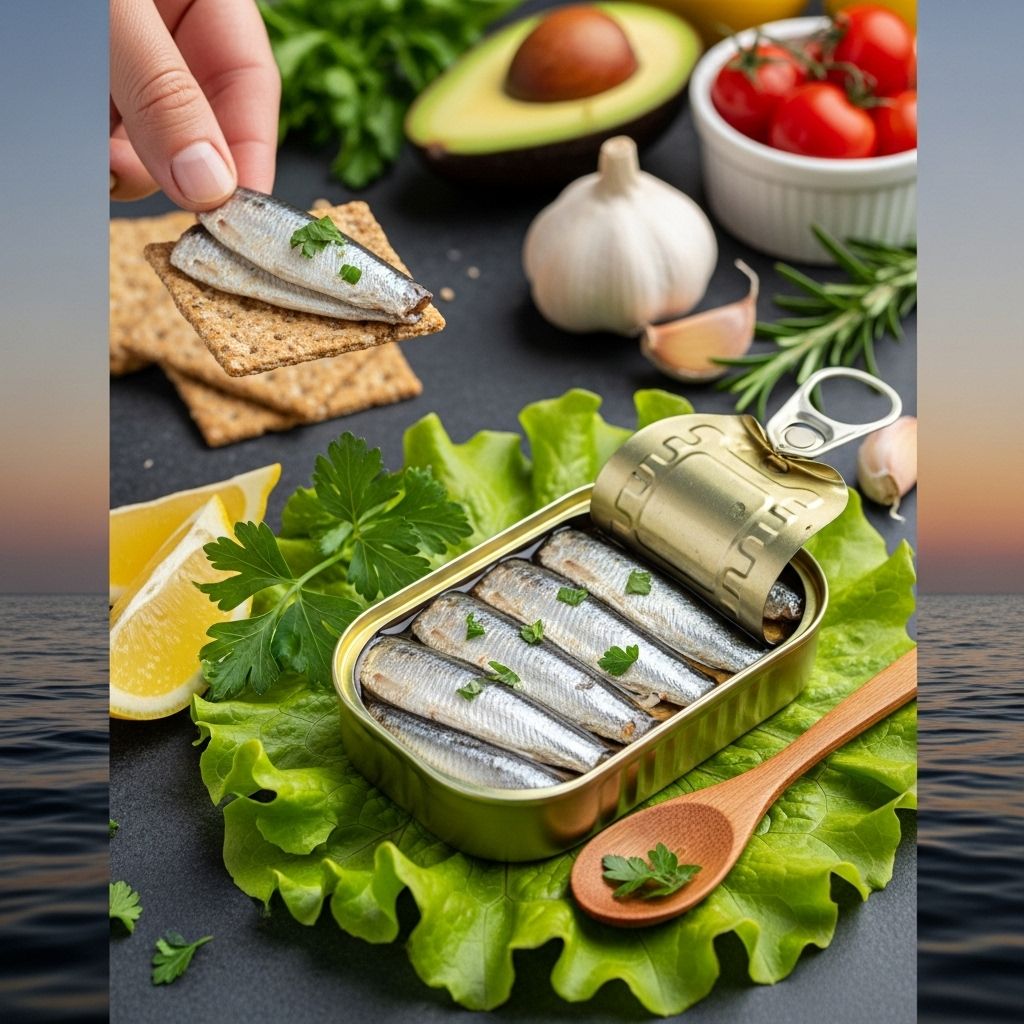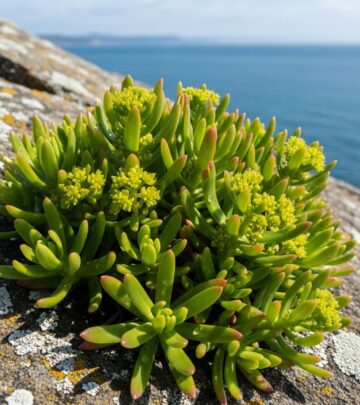Sardines: Nutritional Powerhouse, Versatile Uses, and Unique Taste Explained
Discover how a humble pantry staple brings savory depth, protein power, and eco-friendly promise.

Sardines have long been celebrated for their remarkable nutritional profile, affordability, and adaptability in cuisines worldwide. Small, silvery, and full of flavor, sardines are more than just a humble pantry staple—they are packed with health-promoting nutrients, offer a range of culinary applications, and deliver a distinct taste that attracts dedicated fans and curious food lovers alike.
Table of Contents
- What Are Sardines?
- Taxonomy and Species Variations
- Nutritional Benefits of Sardines
- Health Advantages
- Culinary Uses of Sardines
- Taste and Sensory Profile
- Sustainability and Environmental Impact
- Frequently Asked Questions (FAQs)
What Are Sardines?
Sardines are small, oily fish found in dense schools along the coastal regions of the Atlantic, Pacific, and Mediterranean Seas. Their name is believed to originate from the Italian island of Sardinia, where they can be found in abundance. Sardines belong to several genera, including Sardina, Sardinella, Sardinops, Dussumieria, and Escualosa.
- Sardines usually measure between 8 and 27 cm in length, but commonly reach around 12 cm.
- They have elongated, fusiform-shaped bodies, silvery scales, bluish to grey backs, and a forked tail.
- Their distinctive features include a pointed snout, a terminal mouth, and smooth, deciduous scales.
These pelagic fish thrive in rich, upwelling coastal waters, feeding exclusively on plankton, which contributes to their low mercury levels compared to larger predatory fish. Sardines spawn at an early age, are highly prolific, and play a critical role in marine food chains.
Taxonomy and Species Variations
Taxonomic classification places sardines within the family Clupeidae and subfamily Clupeinae. They share similarities with herring but differ in certain anatomical traits and distribution. Some notable species include:
- Sardina pilchardus (European sardine)
- Sardinops sagax (Pacific sardine)
- Sardinella longiceps (Indian oil sardine)
- Dussumieria elopsoides (Rainbow sardine)
Taxonomic breakdown for sardines:
- Kingdom: Animalia
- Phylum: Chordata
- Class: Actinopterygii
- Order: Clupeiformes
- Family: Clupeidae
Sardines are distributed globally, from temperate to tropical ocean waters. Their reproducibility, fast growth, and adaptability contribute to their commercial importance and environmental resilience.
Nutritional Benefits of Sardines
Sardines are classified among the healthiest seafood choices due to their dense nutritional content. They are considered a ‘blue fish’—high in omega-3 fatty acids, protein, vitamin D, and essential minerals.
| Nutrient | Amount | Role/Benefits |
|---|---|---|
| Protein | ~25g | Muscle growth, satiety, tissue repair |
| Fat | ~11g | Energy source, contains omega-3s |
| Polyunsaturated Fats | ~5g | Heart health, inflammation reduction |
| Carbohydrates | ~1.2g | Minimal impact |
| Calcium | High | Bone health |
| Phosphorus | Significant | Teeth, bone strength, metabolism |
| B Vitamins | Notable | Energy, neurological function |
| Calories | ~200 kcal | Moderate energy food |
Sardines also provide generous amounts of vitamins A, E, B12, and key minerals such as potassium and selenium. Eating sardines with bones further boosts calcium intake, particularly valuable for individuals who avoid dairy.
Health Advantages
Sardines are universally recommended for their wide-ranging health benefits, which include:
- Cardiovascular Health: High levels of omega-3 fatty acids (EPA and DHA) lower triglycerides, reduce blood pressure, and support heart function.
- Brain Function: Omega-3s, vitamin B12, and choline are linked to improved cognitive function and neurological health.
- Bone Strength: Natural calcium, phosphorus, and vitamin D protect against osteoporosis and contribute to bone growth.
- Anti-Inflammatory Properties: Polyunsaturated fats help to reduce inflammation in the body.
- Weight Management: High protein and healthy fats promote satiety and metabolic balance.
- Low Mercury Levels: Sardines feed low on the food chain and consume plankton, which makes them one of the safest fish choices regarding mercury accumulation.
The nutritional density and anti-inflammatory compounds in sardines make them especially beneficial for maintaining a balanced diet, preventing chronic disease, and supporting active lifestyles.
Culinary Uses of Sardines
The culinary versatility of sardines is legendary. Traditionally featured in Mediterranean, Asian, and North African cuisines, sardines can be enjoyed fresh, grilled, roasted, marinated, smoked, or canned. Their preservation through canning has made sardines an essential, convenient ingredient worldwide.
Fresh Sardines
- Grilled: Whole sardines are often lightly seasoned and grilled, resulting in crispy skin and tender flesh.
- Baked: Sardines can be baked with herbs, tomatoes, garlic, and olive oil.
- Stuffed or Roasted: Popular in Mediterranean kitchens—sometimes stuffed with breadcrumbs, aromatic herbs, or nuts.
Canned Sardines
- On Toast: A classic European snack.
- In Salads: Adds protein and healthy fats to vegetable or grain-based salads.
- Mediterranean Dishes: Used in pasta, casseroles, and pizzas.
- Sandwich Spread: Mashed with mayonnaise, mustard, or spices.
Global Dishes Featuring Sardines
- Portuguese Sardinhas Assadas: Flame-grilled sardines seasoned with salt and lemon.
- Italian Pasta con le Sarde: Pasta combined with sardines, fennel, and pine nuts.
- Moroccan Sardine Tagine: Sardines baked in clay pots with tomatoes, peppers, and spices.
- Spanish Escabeche: Sardines marinated in vinegar and spices.
Sardines are prized for their ability to absorb flavors, making them suitable for creative cookery. They are also popular as a savory snack, appetizer, or protein-rich lunch option.
Taste and Sensory Profile
Sardines possess a distinct taste that is robust and slightly briny, often described as “umami-rich,” with a hint of oceanic sweetness. Fresh sardines are mild, clean, and buttery, while canned sardines tend to be richer, more intense, and occasionally smoky, depending on preparation.
- Texture: Tender, flaky, moist flesh with edible skin and bones in canned varieties. Fresh sardines offer firmer texture and crispier skin when grilled.
- Aroma: Mildly fishy, but not overpowering; savory and slightly mineral.
- Flavor Pairings: Sardines pair well with citrus, vinegar, herbs (parsley, dill, fennel), tomatoes, garlic, olive oil, and mild cheeses.
Sardine taste can vary by species, freshness, and method of preservation. The intense, savory flavor profile appeals particularly to those who appreciate bold, natural seafood tastes.
Sustainability and Environmental Impact
Sardines are considered one of the most sustainable seafood choices due to their rapid growth, short lifespan, and high reproductive rates.
- They are efficient at converting plankton into edible protein, minimizing resource consumption.
- Their populations are more resilient to fishing pressures than larger, slower-growing fish.
- Many sardine fisheries are managed with strict quotas and monitored for stock health.
- Eating sardines supports sustainable fishing and reduces reliance on overexploited predatory fish species.
Consumers seeking to make environmentally responsible choices should look for sardines certified by reputable organizations such as the Marine Stewardship Council (MSC).
Frequently Asked Questions (FAQs)
Q: What distinguishes sardines from other small fish?
A: Sardines are part of the Clupeidae family, characterized by silvery, flattened bodies and low mercury levels due to their plankton-based diet. Their rapid reproductive cycle, moderate size, and migratory school behavior set them apart from related species like anchovies and herrings.
Q: Are sardines safe to eat for pregnant women and children?
A: Yes, sardines are a recommended choice due to low mercury and high nutrient densities. Their omega-3s, calcium, and DHA benefit both maternal and child health.
Q: Do canned sardines have the same health benefits as fresh ones?
A: Canned sardines retain most nutrients, including protein, omega-3s, and minerals. The canning process sometimes adds sodium; look for low-salt or unsalted varieties for maximum health advantages.
Q: How should sardines be stored and prepared?
A: Fresh sardines are highly perishable and should be kept refrigerated and prepared within a day or two. Canned sardines are shelf-stable and do not require refrigeration until opened. Both types can be grilled, roasted, or incorporated into recipes for optimal taste and nutrition.
Q: What is the best way to serve sardines for someone who has never tried them?
A: Beginners may enjoy sardines on toast with lemon, in a salad, or grilled with simple herbs. Pair them with acid (lemon, vinegar) and fresh vegetables to balance their rich flavor and aroma.
Summary
Sardines are an extraordinarily nutritious, affordable, and sustainable seafood option celebrated around the globe. Their high protein content, heart-healthy omega-3 fats, vitamins, and minerals make them a dietary cornerstone for anyone seeking optimal health. With a flavor profile ranging from delicate and fresh to robust and savory, sardines adapt to a wide range of dishes and culinary traditions. For environmental advocates and food enthusiasts alike, sardines represent the perfect balance of taste, nutrition, and responsibility.
References
- https://www.biolscigroup.us/articles/AMS-6-127.php
- https://www.vedantu.com/animal/sardine
- https://www.oliocarli.us/magazine/cornucopia-of-taste/sardines-properties-and-benefits
- https://www.tastingtable.com/1275562/facts-about-sardines-should-know/
- https://en.wikipedia.org/wiki/Sardine
- https://a-z-animals.com/animals/sardines/
- https://www.fisheries.noaa.gov/species/pacific-sardine
- https://life-in-water.fandom.com/wiki/Sardine
Read full bio of Sneha Tete












